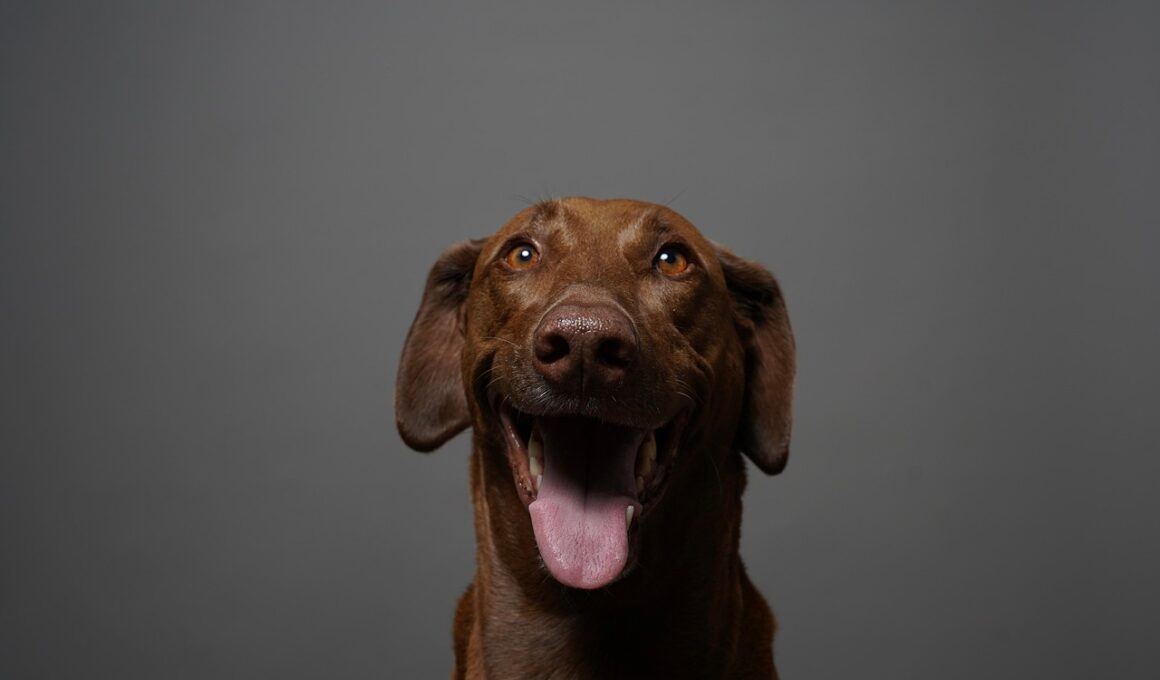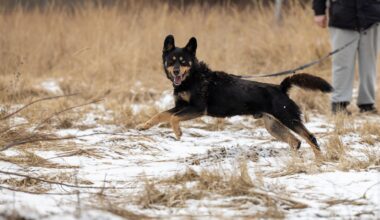Using Patterns and Textures to Highlight Your Dog’s Pose
When capturing your dog’s beauty, patterns and textures play a vital role in emphasizing their pose. Choosing the right background can enhance the colors and fur texture, creating a stunning contrast that draws attention. For instance, photographing your furry friend against a floral backdrop can highlight their playful nature and vibrant coat. Furthermore, experimenting with various fabrics and surfaces like blankets or rugs can add dimension to your shots. Textured surfaces can help ground your dog, making them appear more prominent in the frame. When selecting textures, keep in mind the breed’s fur type; fluffy dogs against a slick surface create a juxtaposition that’s visually appealing. Arranging different props around your dog can also introduce unique patterns without overwhelming their look. Take an outdoor setting; tall grass or colorful leaves serve as exciting elements to frame your images naturally. Pay attention to lighting, as it affects how patterns and textures are perceived in your photos. Utilizing natural light brings out the best in fur patterns and enhances the overall aesthetic of your dog’s expression and pose.
Incorporating patterns into your dog’s photo shoot can significantly impact the overall composition of your images. Using patterned fabrics or backgrounds, such as geometric prints or polka dots, help create a visual rhythm that complements your dog’s features. For an engaging effect, focus on colors that harmonize with your dog’s coat, ensuring the patterns do not compete for attention. An outfit for your dog with playful prints can evoke a cheerful vibe, making the photos feel lively. Moreover, choosing complementary accessories like bandanas or bows can introduce even more pattern opportunities. While posing, allow your dog to interact with these elements, showcasing their personality and charming quirks. For example, if your dog has a relaxed stance, a silky blanket can add a touch of elegance, creating a cozy, inviting scene. Remember that the purpose of these patterns and textures is not only to uplift the visual appeal but also to convey the dog’s story. Every image should reflect their spirit while utilizing these details to create portraits that resonate with viewers on a personal level.
When selecting a location for your photos, consider how the natural textures of the environment can enhance your dog’s pose. For example, a rustic wooden fence can complement a dog’s stature, highlighting their strength and beauty. Incorporating natural elements like flowers, leaves, and stones can add layers to your imagery while clearly showcasing your canine companion. Finding locations that present varied textures allows you to change the mood with each shot, making it easier to capture your dog in relaxed poses as they explore their surroundings. Look for areas with interesting contrasts, such as rough rocks set against soft grass, which can highlight the details in your dog’s coat and posture. Utilize the time of day, as different lighting creates distinct atmospheres and plays off textures beautifully. Early mornings or late afternoons offer the best light, bringing out colors and patterns vibrantly. Additionally, don’t overlook urban landscapes; textures from brick walls or concrete can provide an edgy appearance that suits certain dog breeds. With careful consideration of your surroundings, you’ll create images that both celebrate your dog’s spirit and showcase stunning visuals.
Experimenting with Props
Props significantly enhance the composition of photographs by introducing layers and interesting textures. Using items like colorful pillows, vibrant toys, or patterned throws can create a dynamic feel to the portrait. When posing your dog next to or within these props, ensure that they complement your dog’s color and texture, boosting visual appeal without becoming distractive. A bright ball can draw attention to your dog’s playful side, inviting them to interact and elongating their natural pose. Moreover, seasonal props—think pumpkins in autumn or flowers in spring—can tell stories and capture your dog’s personality during various times of the year. When incorporating props, pay attention to their stability, particularly with energetic dogs that might disrupt setups. Balance playful interactions with a calm pose to yield photographs that resonate with their personality. Remember, the goal isn’t just to showcase your dog’s beauty but to tell a story through the textures and patterns introduced by props. Capture candid moments and choreographed poses, utilizing everything around you creatively to highlight your dog’s unique spirit effectively.
Considering the time of year can introduce seasonal patterns that enhance your photos. Seasonal elements such as blooming flowers in spring, colorful leaves in autumn, or even holiday decorations can create a vibrant backdrop that elevates your dog’s poses. These patterns can evoke emotions and memories, transporting viewers to specific times of the year. For instance, a cozy winter setting, with your dog snuggled in a soft blanket by the fireplace, gives a warm, heartwarming aesthetic. It is essential to choose elements that not only highlight your dog’s features but also work well with their color and fur texture. Consider how light plays on natural patterns too; soft shadows from leafy trees can produce captivating images that add depth. You can also find seasonal fabrics, like checks and plaids, that match your dog’s unique aesthetic, creating a harmonious composition. Incorporating elements from different seasons invites a change in mood and atmosphere, providing versatility in your portfolio of dog photography. Doing so creates visual storytelling opportunities uniquely showcasing your canine companions throughout the year.
Lighting Techniques
Lighting is crucial in enhancing patterns and textures during dog photography. Without correct lighting, even the most beautifully posed dog can appear flat and uninteresting. Natural light works wonders, especially during the golden hour when sunlight is warm and diffusive. This soft light emphasizes fur texture and patterns, highlighting every detail with stunning clarity. If shooting indoors, consider positioning near windows for natural illumination that bathes your dog in soft light. Avoid harsh overhead lights, as they can cast unflattering shadows. Instead, you can utilize reflectors to bounce light onto your dog, enhancing their fur patterns without diminishing their natural essence. Conversely, using backlighting creates silhouettes and compelling contrasts, allowing textures to pop dramatically. Adjusting your angles during the shoot can reveal different aspects of your dog’s features, ensuring patterns come across vividly. Experimenting with various lighting techniques can yield unexpected yet beautiful outcomes. Play around with shadows and highlights; they provide depth to your photographs while emphasizing your dog’s personality, making every image a unique work of art capable of capturing the viewers’ attention.
In post-processing, handling patterns and textures can further enhance the final images of your dog’s poses. By adjusting contrast and saturation, you can draw out color vibrancy and texture richness, creating photos that captivate the viewer even more. Make sure you remain true to the dog’s essence while refining the details in editing; your goal is to elevate without overshadowing the original beauty. Techniques like sharpening can improve texture visibility, making fur appear more defined, while blurring backgrounds can provide a more pronounced focus on your dog. Filters can introduce harmonic colors and patterns, enriching the overall aesthetic while maintaining your dog’s characteristic features. Moreover, remember to maintain a balance—over-editing can lead to artificial appearances. Strive for a natural yet polished look, allowing your dog’s personality to shine through the photograph. Explore various editing tools available in software programs; many offer functionalities tailored to enhancing textures specifically. With patience and creativity, post-processing becomes a valuable part of highlighting the patterns and textures that define your dog’s pose beautifully.
Final Thoughts
Photography of dogs involves so much more than just pointing and clicking. Understanding how patterns and textures influence visual storytelling allows you to create impactful images that resonate with viewers. By thoughtfully incorporating various backgrounds, props, and lighting, you can elevate your photography game significantly. Ensure you remain flexible and open to experimentation, as dogs often offer candid moments that lead to the most enriching photographs. Whether seeking to capture the playful energy of puppies or the serene elegance of older dogs, focusing on these aspects will help bring out the best in every pose. Always approach your shoots with a creative mindset and an eye for detail. With practice and a keen understanding of your dog’s character, the resulting photographs will tell a unique narrative and capture their essence beautifully. As you harness the power of patterns and textures in your canine photography, remember that every dog has a story to share. Positioning your camera to capture it will not only create beautiful images but also strengthen your bond with your furry friend over time.


